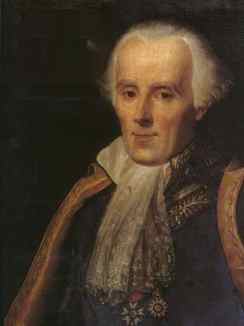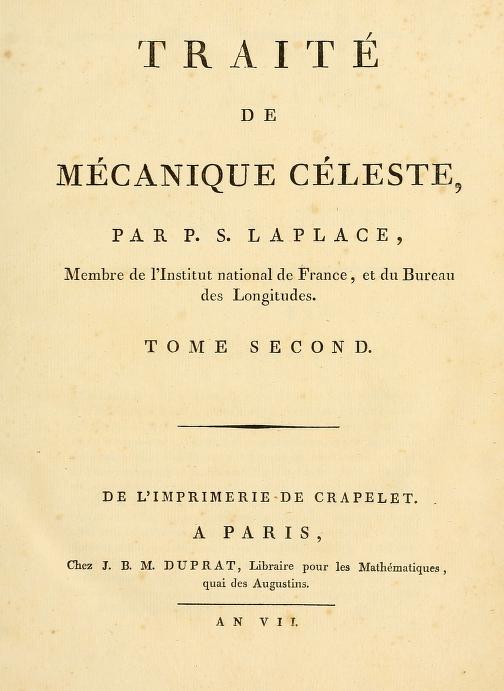| Line 12: | Line 12: | ||
In the 1790's and 1800's, his work broadened to a study of the solar system. A common and far-reaching mathematical and physical problem at the time was proving the stability of the solar system. While France was experiencing upheaval from the revolution and the Napoleonic Era, Laplace continued working and focused on his study of physics and its integration with mathematics. | In the 1790's and 1800's, his work broadened to a study of the solar system. A common and far-reaching mathematical and physical problem at the time was proving the stability of the solar system. While France was experiencing upheaval from the revolution and the Napoleonic Era, Laplace continued working and focused on his study of physics and its integration with mathematics. | ||
| − | In 1798, Laplace published his magnum opus, the | + | In 1798, Laplace published his magnum opus, the ``Mécanique Céleste``. This book studied the solar system and the ways in which the planets moved. In it, Laplace introduced the Laplace equation, which he used as a potential function to simplify his study of the gravitational field. Incidentally, this showed the use of the Laplace operator, and how it could be used in physics and mathematics. In this, Laplace created what is arguably his greatest contribution to modern differential calculus. |
<center> | <center> | ||
[[File: Laplacebook.jpg]] | [[File: Laplacebook.jpg]] | ||
| − | Laplace's most famous work, the | + | Laplace's most famous work, the ``Traité de Mécanique Céleste``, in which he used the Laplace equation and the Laplace operator. |
</center> | </center> | ||
[[Walther_MA271_Fall2020_topic9|Back to main page]] | [[Walther_MA271_Fall2020_topic9|Back to main page]] | ||
Revision as of 20:53, 6 December 2020
Background: Laplace and the History of the Laplace Operator
History of Laplace
Born in 1749, Pierre-Simon Laplace was born into a middle class family in a time when mathematics and science was broadening its horizon to a greater understanding of physics, chemistry, astronomy, and the ways in which the world works.

He did his first work on differential calculus and Lagrange mathematics in 1770, setting up the precursor to his future studies in the form of the Laplace operator and other fields of differential calculus. During this time, he developed a relationship with Jean le Rond d'Alembert, a famous and well-respected mathematician of the time period.
In the 1790's and 1800's, his work broadened to a study of the solar system. A common and far-reaching mathematical and physical problem at the time was proving the stability of the solar system. While France was experiencing upheaval from the revolution and the Napoleonic Era, Laplace continued working and focused on his study of physics and its integration with mathematics.
In 1798, Laplace published his magnum opus, the ``Mécanique Céleste``. This book studied the solar system and the ways in which the planets moved. In it, Laplace introduced the Laplace equation, which he used as a potential function to simplify his study of the gravitational field. Incidentally, this showed the use of the Laplace operator, and how it could be used in physics and mathematics. In this, Laplace created what is arguably his greatest contribution to modern differential calculus.
Laplace's most famous work, the ``Traité de Mécanique Céleste``, in which he used the Laplace equation and the Laplace operator.


